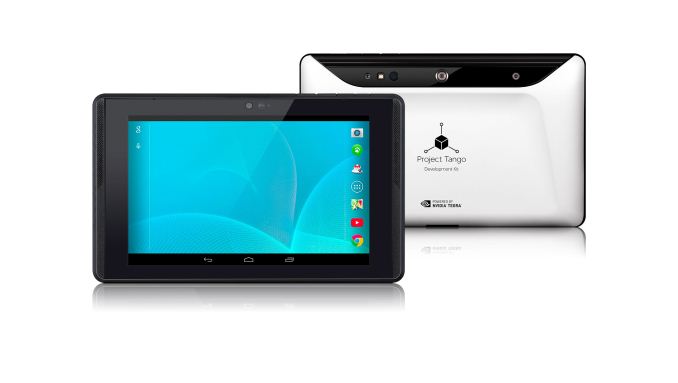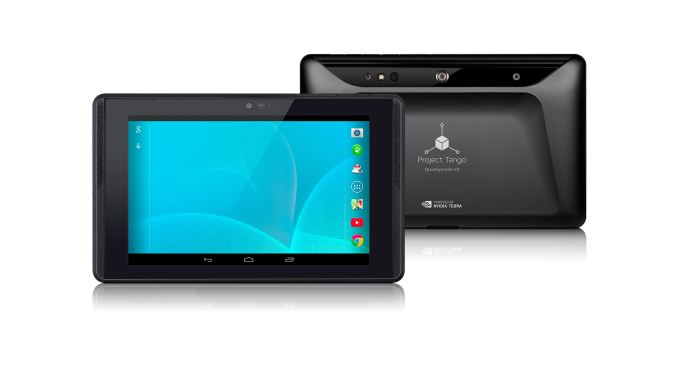Google Announces Project Tango Tablet Dev Kit with Tegra K1 and 3D Capture/Tracking
by Jarred Walton on June 5, 2014 1:18 PM EST- Posted in
- Tablets
- Mobile
- NVIDIA
- Tegra K1
- Project Tango
- 3D imaging

Google recently announced their new Project Tango Development Kit, a 7" tablet with a unique twist. At present this is a device for developers, scientists, and other research-oriented groups more than something for end users, but as with most Google projects the end goal is obviously to help create something that will end up being a useful addition to a retail product. You can read more about Project Tango, but the main point of interest is that the devices contain hardware and software that allows them to track and map 3D environments. Google states that the sensors make over a quarter million 3D measurements every second, updating its position and orientation in real-time.
It seems like if Google gets enough of these things running around the world, they could combine all that data into an impressively detailed 3D map of the entire world (well, the populated parts at least). Google Earth could certainly benefit from that sort of data, but there are plenty other uses for such technology as well. NVIDIA's blog on the subject notes that games could map out your living room (or yard, office, neighborhood, etc.), or a real estate agent (or architect) could use it to create a 3D model of a house/building and provide a virtual walkthrough for clients. Uses in the robotics field are another option, and robotics research has already seen great benefits of integrating Microsoft's Kinect sensor into various designs.
Along with the new information on Project Tango comes the announcement of the latest development kit hardware. (Note that this is the second Project Tango device; the first was a smartphone.) Compared to many tablets currently out there, the specs are quite impressive: NVIDIA Tegra K1 SoC, 4GB RAM, 128GB storage, and of course all the sensors needed to track motion and map environments. Basically, imagine a tablet/smartphone with Kinect-style sensors integrated into the product. (Update: Mantis Vision just announced that they will be providing the core 3D engine for Project Tango.) The device itself is a 7-inch tablet, though the screen resolution wasn't divulged, and it will be running the latest version of Android (KitKat 4.4).
If that sounds enticing, there are two more items you'll need to know: first is that the development kits will be made available "later this year", so this is not yet shipping hardware. Second, the cost of the development kit is $1024 (a nod to computer geeks and our infatuation with powers of two, I suppose). NVIDIA sent along two rendered images of the Project Tango tablet, showing black and white casings.
Source: NVIDIA Blog











33 Comments
View All Comments
NXTwoThou - Thursday, June 5, 2014 - link
I'm interested in the resolution and accuracy. The marketing speak all seems to be about large scale scanning. Would be nice if it was flipable into small scale.JeffFlanagan - Thursday, June 5, 2014 - link
At $500, I'd probably get one just to play around with, but you'd have to be pretty serious about using the device to pay over $1k. It'll be interesting to see how many they sell.UpSpin - Thursday, June 5, 2014 - link
And just as with Google Glass or Oculus Rift or ... this is not a device for consumers, but for developers. Google doesn't care how many they sell, they just want developers to find a usage for this technology. That's the reason this tablet has such high specs. Google doesn't know exactly what to do with the technology, they have ideas and are interested in it and allow others to experiment with it, to make this technolgy worth some money.JeffFlanagan - Thursday, June 5, 2014 - link
They don't care how many they sell, but I'm sure they care about getting them into the hands of developers, and this developer isn't going to spend over $500 on something that has unproven potential to help me earn my living. I expect that plenty of other people will though, so I'm no loss to Google.mayankleoboy1 - Thursday, June 5, 2014 - link
I wanted an AMD APU instead of teh K1 in a google device. AMD needs google to survive, and I'm sick of Nvidias crappy SoC's.HisDivineOrder - Thursday, June 5, 2014 - link
AMD APU's wouldn't have the battery life of an nVidia Tegra K1.fteoath64 - Friday, June 6, 2014 - link
Neither would the APU have enough horsepower to drive the tablet and needed internal fans likes the latest Broadwell superslim Win-tablets, so K1 is the ONLY choice within the required time line. QC is NOT going to rush a special S805 just to win this "small" deal of Google.Besides the gpu feature set of K1 is proven with lots of software compatibility in Tesla workstations. So advanced developers of vision based apps will drool over this developer kit.
CiccioB - Thursday, June 5, 2014 - link
Crappy SoCs are still better than no SoCs.How many AMD ARM based SoC do you know? Or even a x86 SoC that enters nvidia K1 power envelop?
AMD needs to release adequate products to survive, no count on others. If others do something, good or not depend on your point of view but the products do exist for AMD competitors, while AMD performs long sleeps it is only their fault.
They have missed all new markets in latest years. Starting from GPGPU by constantly developing that useless (for GPGPU) VLIW architecture and lastly presenting a GPU capable architecture with zero SW support, to netbooks by releasing an Atom like crap chip 4 years later when the nebooks hype were already ended, to the mobile market where they have no ARM based products not low power x86 based ones.
AMD needs products, and good ones if they want to survive with all these new competitors that are reducing x86 market. Counting on others just means they won't survive as others do their own interests, not AMD's ones.
Death666Angel - Thursday, June 5, 2014 - link
"Crappy SoCs are still better than no SoCs.How many AMD ARM based SoC do you know? Or even a x86 SoC that enters nvidia K1 power envelop?"
Tegra K1 uses 11W when at full tilt and typically between 5 and 8W as with most performance SoCs these days. AMDs Kabini can reach that low (9W) with the E1-2100 and Temash are all between 3.9W and 8W. They are all also SoCs with not need for an FCH.
CiccioB - Friday, June 6, 2014 - link
Idle consumption is the most important carachteristics for mobile SoCs, as you usually do not leave yor tablet running hours doing some work. How low are AMD Soc going in power consumption? What's the perfomance of a 5W x86 SoC vs a 5W ARM SoC? How big (and costly is) a x86 SoC that can deliver K1 performances?And you know, an ARM SoC is not only a CPU+GPU. There are many other components that allow to save power in many cases, like for example listening to MP3, watching video, doing light weight work, things that a x86 SoC is (still) not able to do.
You see, you look at raw numbers from the wrong point of view of someone like me that doesn't really know anything about how those SoCs works and perform. Look at them from the other side of the wall: if AMD (and Intel as well) produced good SoCs they would be used in place of Qualcomm/Mediatek/nvidia ones, don't you believe?